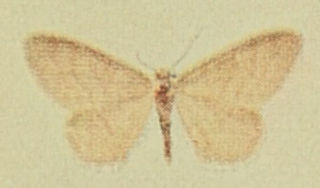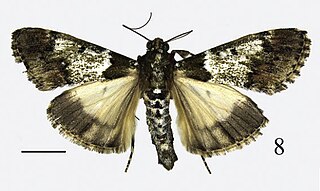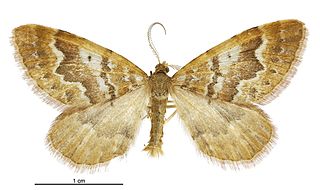
The brimstone moth is a moth of the family Geometridae. The species was first described by Carl Linnaeus in his 1758 10th edition of Systema Naturae. It should not be confused with the brimstone butterfly Gonepteryx rhamni.

The brindled beauty is a Palearctic moth belonging to the family Geometridae.

Plagodis pulveraria, the barred umber, is a moth of the family Geometridae. The species was first described by Carl Linnaeus in his 1758 10th edition of Systema Naturae. It is found throughout much of the Palearctic realm from Ireland to Japan, and in the Nearctic realm (Canada).

Idaea subsericeata, the satin wave, is a moth of the family Geometridae. The species was first described by Adrian Hardy Haworth in 1809. It is found from central and southern Europe, North Africa, Asia Minor to Transcaspia.

Idaea dilutaria, also called the silky wave, is a moth of the family Geometridae. It is found in Europe.

The cloaked pug is a moth of the family Geometridae. The species was first described by Johann August Ephraim Goeze in 1781 and it can be found in Europe and to the east in Siberia and Japan.

Ercheia is a genus of moths in the family Erebidae. The genus was erected by Francis Walker in 1858.

Paradarisa consonaria, the brindled square spot or square spot, is a moth of the family Geometridae. It is found in north and central Europe and east to south-eastern Siberia and Japan.

Catarhoe cuculata, the royal mantle, is a moth of the family Geometridae. The species was first described by Johann Siegfried Hufnagel in 1767. It is found from Europe to western Central Asia and east Siberia. The species prefers to live in light forests and forest edges, but also occurs on meadows.

Eupithecia denotata is a moth in the family Geometridae. The species can be found across the Palearctic from western Europe to Central Asia and China.

Philereme transversata, the dark umber, is a moth of the family Geometridae. It is found in much of the Palearctic realm.
Achaea dmoe is a species of moth of the family Erebidae first described by Louis Beethoven Prout in 1919. It is found on Madagascar.
Ercheia latistria is a species of moth of the family Erebidae. It is found in Indonesia, where it has been recorded from Halmahera.
Pseudotelphusa trinephela is a moth of the family Gelechiidae. It is found in Zimbabwe.

Teliphasa spinosa is a species of moth of the family Pyralidae. It is found in China (Yunnan).

Teliphasa erythrina is a species of moth of the family Pyralidae. It is found in China (Yunnan).

Teliphasa hamata is a species of moth of the family Pyralidae. It is found in China.

Udea albostriata is a moth in the family Crambidae. It was first described by Zhang and Li in 2016. It is found in Hebei, China.

Asaphodes dionysias is a species of moth in the family Geometridae. This species is endemic to New Zealand and is only known from mountainous areas in Central Otago. It lives in open grassy mountainous habitat at altitudes up to 1750 m. It is also known to live in wetland habitat. The larvae of this species feed on native herbs. The adults of this species are on the wing in January and February. The adult female of the species has reduced wing size in comparison to the male.

Asaphodes exoriens is a species of moth in the family Geometridae. This species is endemic to New Zealand and has been found in Central Otago. This is an alpine species and frequents open grassy habitat. They can also be found in upland wetland habitat at altitudes between 800 and 1100 m. Adults are on the wing in March.
















